International Business: Market Entry Risks and Opportunities Report
VerifiedAdded on 2022/09/26
|7
|1346
|22
Report
AI Summary
This report delves into the multifaceted world of international business, focusing on the challenges and opportunities that global companies face when entering new markets. The introduction emphasizes the significance of market opportunities, cost advantages, and favorable government policies in driving international expansion, while also acknowledging the inherent risks such as political instability and cross-cultural differences. The report explores political risks, highlighting how uncertainties in policies and corruption can hinder foreign investment. It then examines market opportunities, such as access to new customers and cost advantages, using examples like Coca-Cola and Boeing. Furthermore, the analysis covers cross-cultural risks, emphasizing the potential for missteps due to language barriers and cultural nuances, and the importance of understanding local consumer behavior. The conclusion underscores the need for businesses to carefully assess political and cross-cultural risks while capitalizing on market opportunities for successful global ventures. The report provides a comprehensive overview of the key elements involved in international business, making it a valuable resource for students studying business development and international markets.
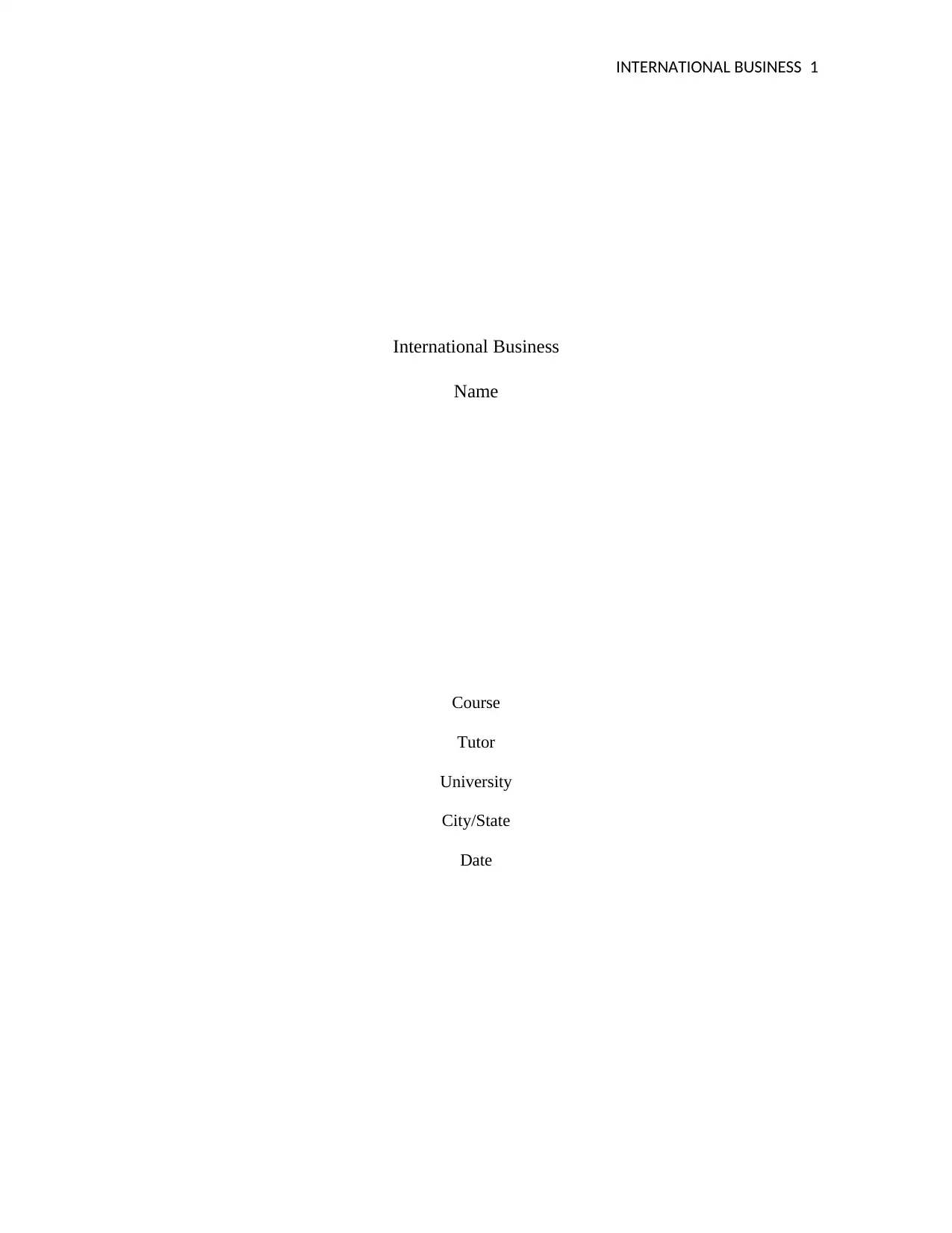
INTERNATIONAL BUSINESS 1
International Business
Name
Course
Tutor
University
City/State
Date
International Business
Name
Course
Tutor
University
City/State
Date
Paraphrase This Document
Need a fresh take? Get an instant paraphrase of this document with our AI Paraphraser
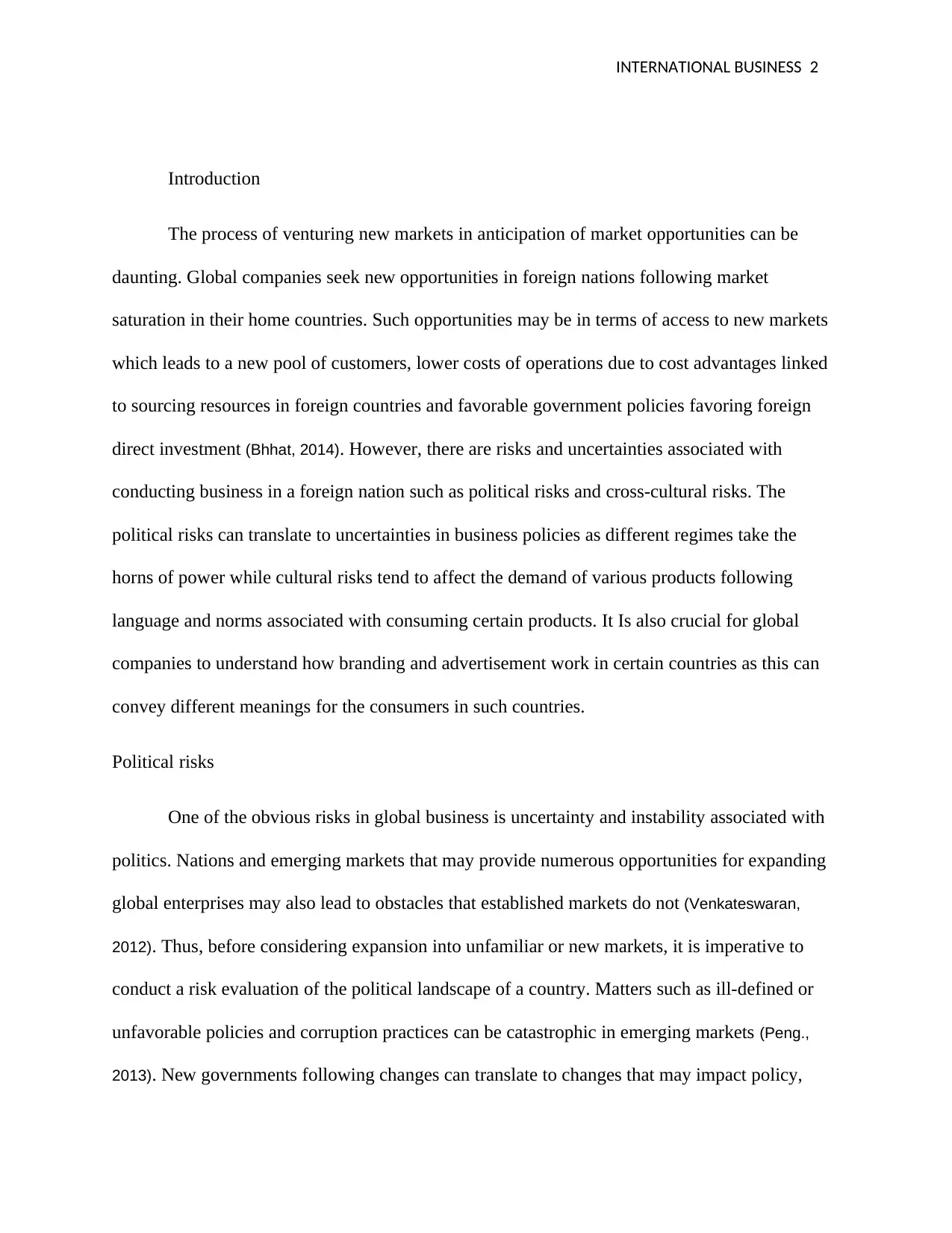
INTERNATIONAL BUSINESS 2
Introduction
The process of venturing new markets in anticipation of market opportunities can be
daunting. Global companies seek new opportunities in foreign nations following market
saturation in their home countries. Such opportunities may be in terms of access to new markets
which leads to a new pool of customers, lower costs of operations due to cost advantages linked
to sourcing resources in foreign countries and favorable government policies favoring foreign
direct investment (Bhhat, 2014). However, there are risks and uncertainties associated with
conducting business in a foreign nation such as political risks and cross-cultural risks. The
political risks can translate to uncertainties in business policies as different regimes take the
horns of power while cultural risks tend to affect the demand of various products following
language and norms associated with consuming certain products. It Is also crucial for global
companies to understand how branding and advertisement work in certain countries as this can
convey different meanings for the consumers in such countries.
Political risks
One of the obvious risks in global business is uncertainty and instability associated with
politics. Nations and emerging markets that may provide numerous opportunities for expanding
global enterprises may also lead to obstacles that established markets do not (Venkateswaran,
2012). Thus, before considering expansion into unfamiliar or new markets, it is imperative to
conduct a risk evaluation of the political landscape of a country. Matters such as ill-defined or
unfavorable policies and corruption practices can be catastrophic in emerging markets (Peng.,
2013). New governments following changes can translate to changes that may impact policy,
Introduction
The process of venturing new markets in anticipation of market opportunities can be
daunting. Global companies seek new opportunities in foreign nations following market
saturation in their home countries. Such opportunities may be in terms of access to new markets
which leads to a new pool of customers, lower costs of operations due to cost advantages linked
to sourcing resources in foreign countries and favorable government policies favoring foreign
direct investment (Bhhat, 2014). However, there are risks and uncertainties associated with
conducting business in a foreign nation such as political risks and cross-cultural risks. The
political risks can translate to uncertainties in business policies as different regimes take the
horns of power while cultural risks tend to affect the demand of various products following
language and norms associated with consuming certain products. It Is also crucial for global
companies to understand how branding and advertisement work in certain countries as this can
convey different meanings for the consumers in such countries.
Political risks
One of the obvious risks in global business is uncertainty and instability associated with
politics. Nations and emerging markets that may provide numerous opportunities for expanding
global enterprises may also lead to obstacles that established markets do not (Venkateswaran,
2012). Thus, before considering expansion into unfamiliar or new markets, it is imperative to
conduct a risk evaluation of the political landscape of a country. Matters such as ill-defined or
unfavorable policies and corruption practices can be catastrophic in emerging markets (Peng.,
2013). New governments following changes can translate to changes that may impact policy,
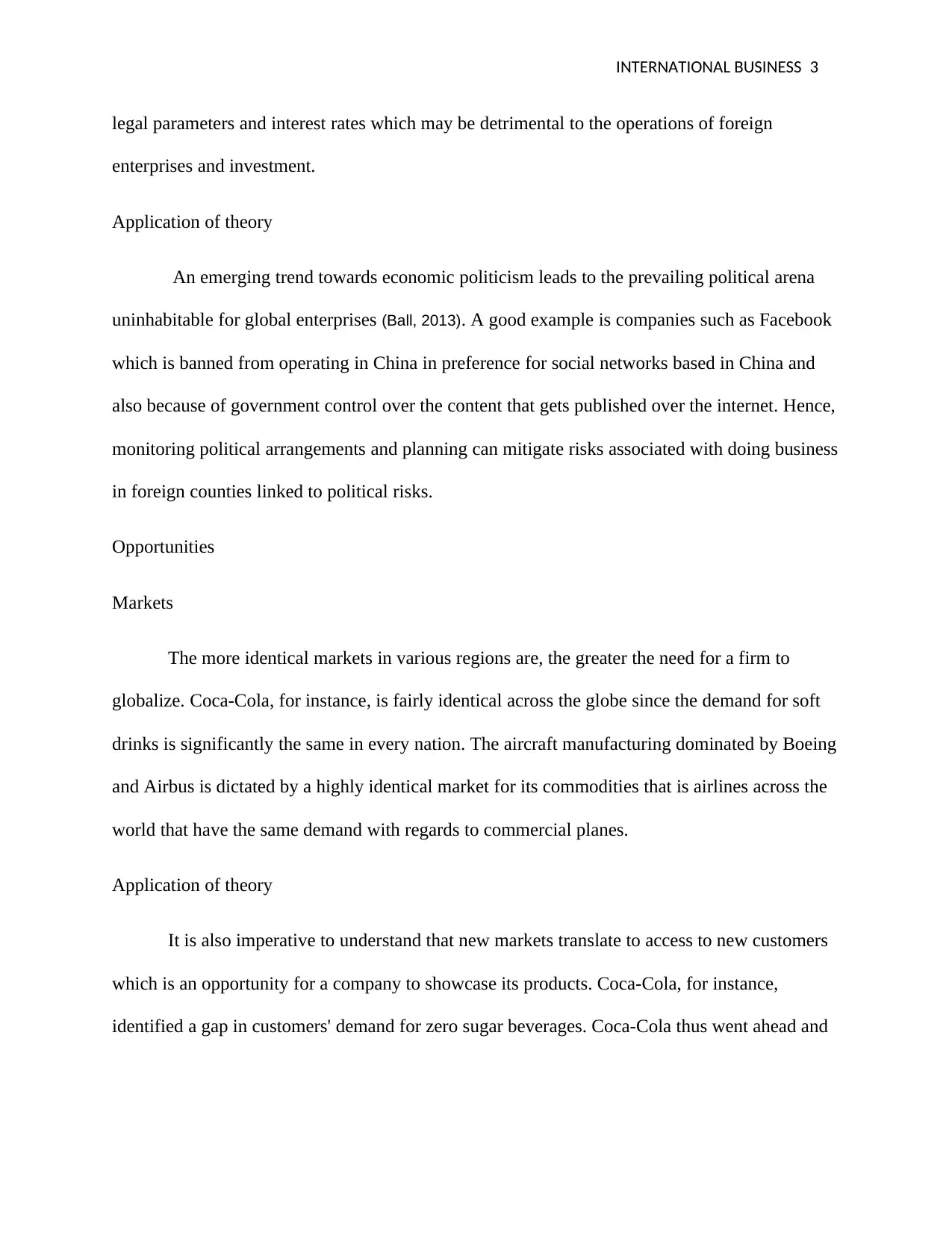
INTERNATIONAL BUSINESS 3
legal parameters and interest rates which may be detrimental to the operations of foreign
enterprises and investment.
Application of theory
An emerging trend towards economic politicism leads to the prevailing political arena
uninhabitable for global enterprises (Ball, 2013). A good example is companies such as Facebook
which is banned from operating in China in preference for social networks based in China and
also because of government control over the content that gets published over the internet. Hence,
monitoring political arrangements and planning can mitigate risks associated with doing business
in foreign counties linked to political risks.
Opportunities
Markets
The more identical markets in various regions are, the greater the need for a firm to
globalize. Coca-Cola, for instance, is fairly identical across the globe since the demand for soft
drinks is significantly the same in every nation. The aircraft manufacturing dominated by Boeing
and Airbus is dictated by a highly identical market for its commodities that is airlines across the
world that have the same demand with regards to commercial planes.
Application of theory
It is also imperative to understand that new markets translate to access to new customers
which is an opportunity for a company to showcase its products. Coca-Cola, for instance,
identified a gap in customers' demand for zero sugar beverages. Coca-Cola thus went ahead and
legal parameters and interest rates which may be detrimental to the operations of foreign
enterprises and investment.
Application of theory
An emerging trend towards economic politicism leads to the prevailing political arena
uninhabitable for global enterprises (Ball, 2013). A good example is companies such as Facebook
which is banned from operating in China in preference for social networks based in China and
also because of government control over the content that gets published over the internet. Hence,
monitoring political arrangements and planning can mitigate risks associated with doing business
in foreign counties linked to political risks.
Opportunities
Markets
The more identical markets in various regions are, the greater the need for a firm to
globalize. Coca-Cola, for instance, is fairly identical across the globe since the demand for soft
drinks is significantly the same in every nation. The aircraft manufacturing dominated by Boeing
and Airbus is dictated by a highly identical market for its commodities that is airlines across the
world that have the same demand with regards to commercial planes.
Application of theory
It is also imperative to understand that new markets translate to access to new customers
which is an opportunity for a company to showcase its products. Coca-Cola, for instance,
identified a gap in customers' demand for zero sugar beverages. Coca-Cola thus went ahead and
⊘ This is a preview!⊘
Do you want full access?
Subscribe today to unlock all pages.

Trusted by 1+ million students worldwide
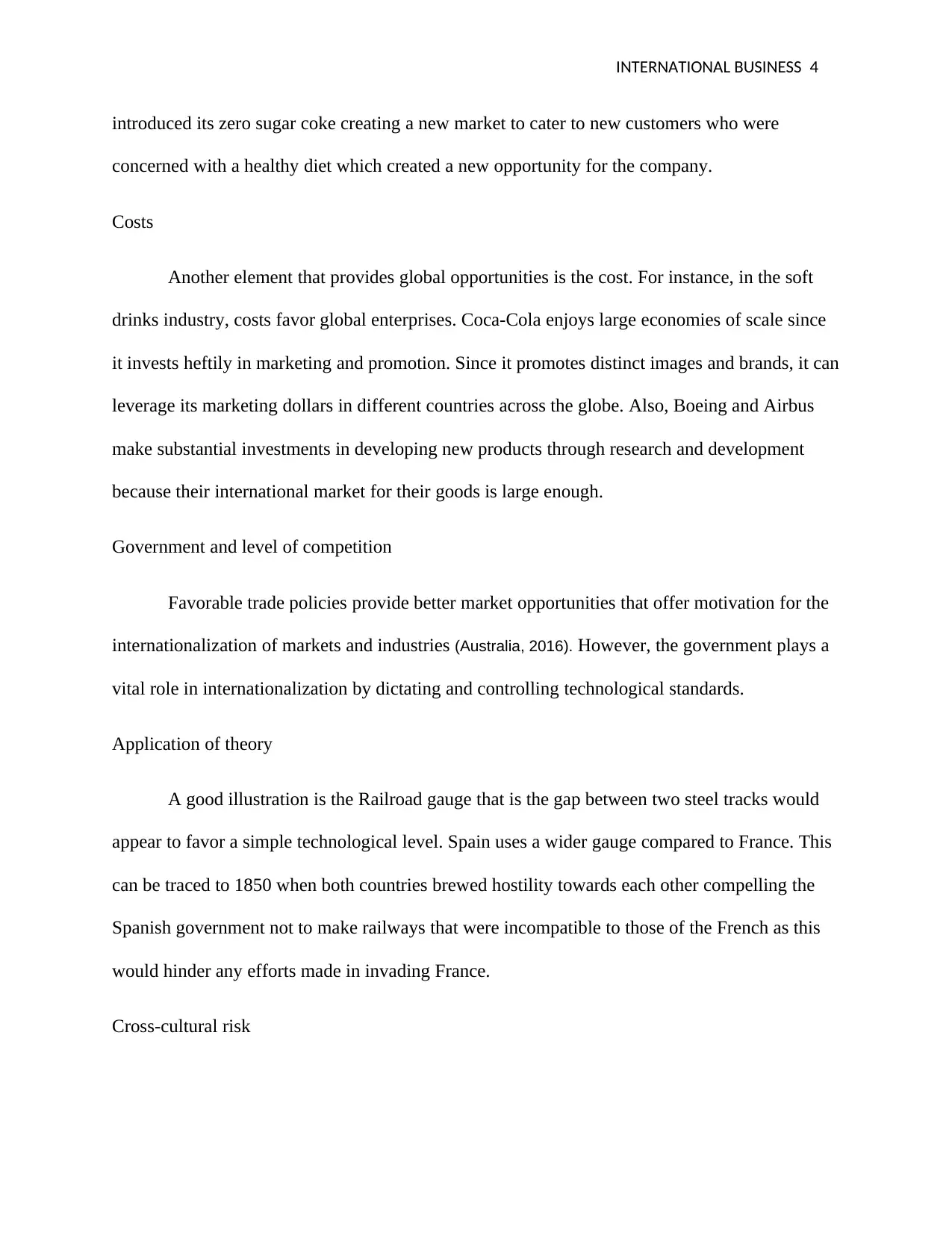
INTERNATIONAL BUSINESS 4
introduced its zero sugar coke creating a new market to cater to new customers who were
concerned with a healthy diet which created a new opportunity for the company.
Costs
Another element that provides global opportunities is the cost. For instance, in the soft
drinks industry, costs favor global enterprises. Coca-Cola enjoys large economies of scale since
it invests heftily in marketing and promotion. Since it promotes distinct images and brands, it can
leverage its marketing dollars in different countries across the globe. Also, Boeing and Airbus
make substantial investments in developing new products through research and development
because their international market for their goods is large enough.
Government and level of competition
Favorable trade policies provide better market opportunities that offer motivation for the
internationalization of markets and industries (Australia, 2016). However, the government plays a
vital role in internationalization by dictating and controlling technological standards.
Application of theory
A good illustration is the Railroad gauge that is the gap between two steel tracks would
appear to favor a simple technological level. Spain uses a wider gauge compared to France. This
can be traced to 1850 when both countries brewed hostility towards each other compelling the
Spanish government not to make railways that were incompatible to those of the French as this
would hinder any efforts made in invading France.
Cross-cultural risk
introduced its zero sugar coke creating a new market to cater to new customers who were
concerned with a healthy diet which created a new opportunity for the company.
Costs
Another element that provides global opportunities is the cost. For instance, in the soft
drinks industry, costs favor global enterprises. Coca-Cola enjoys large economies of scale since
it invests heftily in marketing and promotion. Since it promotes distinct images and brands, it can
leverage its marketing dollars in different countries across the globe. Also, Boeing and Airbus
make substantial investments in developing new products through research and development
because their international market for their goods is large enough.
Government and level of competition
Favorable trade policies provide better market opportunities that offer motivation for the
internationalization of markets and industries (Australia, 2016). However, the government plays a
vital role in internationalization by dictating and controlling technological standards.
Application of theory
A good illustration is the Railroad gauge that is the gap between two steel tracks would
appear to favor a simple technological level. Spain uses a wider gauge compared to France. This
can be traced to 1850 when both countries brewed hostility towards each other compelling the
Spanish government not to make railways that were incompatible to those of the French as this
would hinder any efforts made in invading France.
Cross-cultural risk
Paraphrase This Document
Need a fresh take? Get an instant paraphrase of this document with our AI Paraphraser
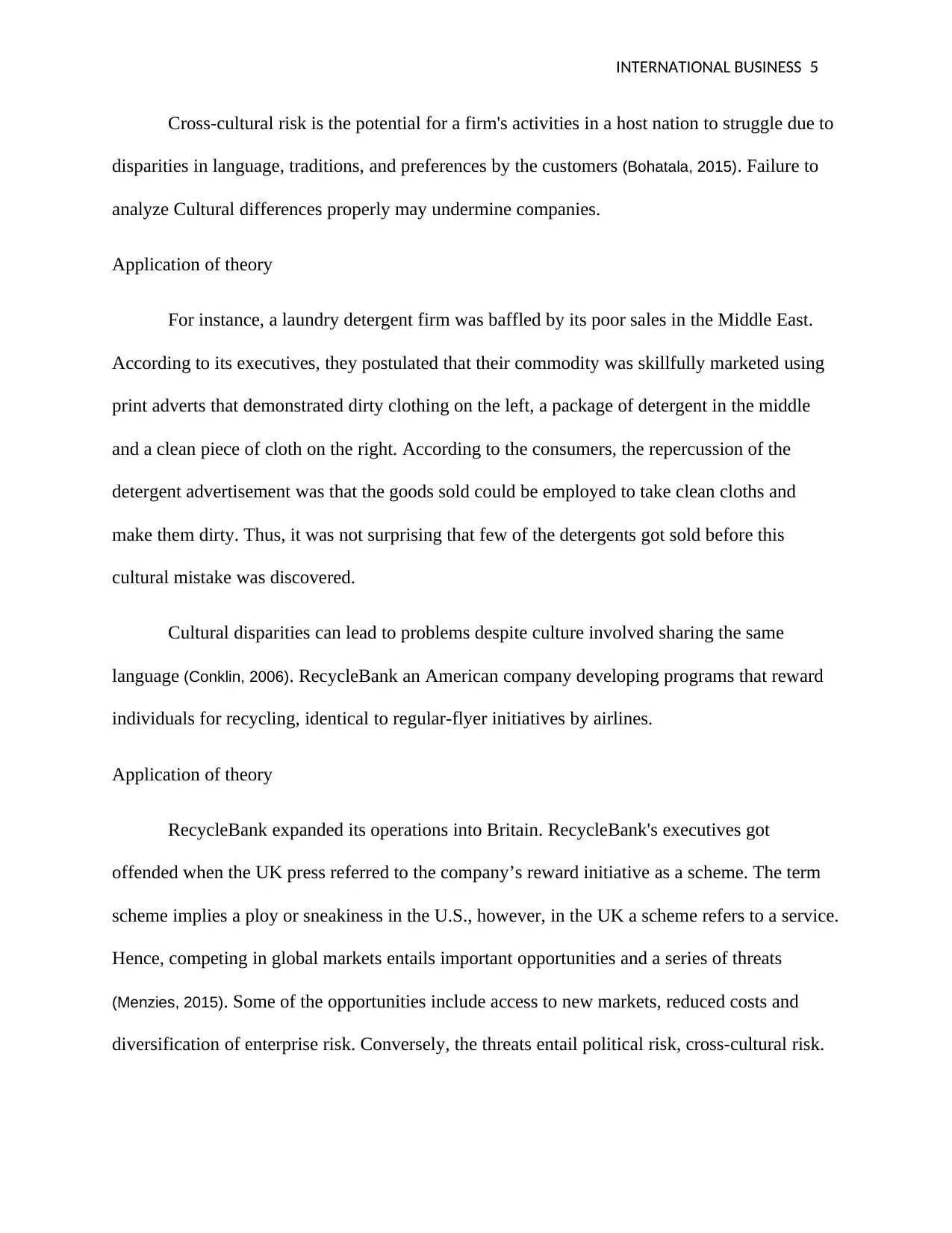
INTERNATIONAL BUSINESS 5
Cross-cultural risk is the potential for a firm's activities in a host nation to struggle due to
disparities in language, traditions, and preferences by the customers (Bohatala, 2015). Failure to
analyze Cultural differences properly may undermine companies.
Application of theory
For instance, a laundry detergent firm was baffled by its poor sales in the Middle East.
According to its executives, they postulated that their commodity was skillfully marketed using
print adverts that demonstrated dirty clothing on the left, a package of detergent in the middle
and a clean piece of cloth on the right. According to the consumers, the repercussion of the
detergent advertisement was that the goods sold could be employed to take clean cloths and
make them dirty. Thus, it was not surprising that few of the detergents got sold before this
cultural mistake was discovered.
Cultural disparities can lead to problems despite culture involved sharing the same
language (Conklin, 2006). RecycleBank an American company developing programs that reward
individuals for recycling, identical to regular-flyer initiatives by airlines.
Application of theory
RecycleBank expanded its operations into Britain. RecycleBank's executives got
offended when the UK press referred to the company’s reward initiative as a scheme. The term
scheme implies a ploy or sneakiness in the U.S., however, in the UK a scheme refers to a service.
Hence, competing in global markets entails important opportunities and a series of threats
(Menzies, 2015). Some of the opportunities include access to new markets, reduced costs and
diversification of enterprise risk. Conversely, the threats entail political risk, cross-cultural risk.
Cross-cultural risk is the potential for a firm's activities in a host nation to struggle due to
disparities in language, traditions, and preferences by the customers (Bohatala, 2015). Failure to
analyze Cultural differences properly may undermine companies.
Application of theory
For instance, a laundry detergent firm was baffled by its poor sales in the Middle East.
According to its executives, they postulated that their commodity was skillfully marketed using
print adverts that demonstrated dirty clothing on the left, a package of detergent in the middle
and a clean piece of cloth on the right. According to the consumers, the repercussion of the
detergent advertisement was that the goods sold could be employed to take clean cloths and
make them dirty. Thus, it was not surprising that few of the detergents got sold before this
cultural mistake was discovered.
Cultural disparities can lead to problems despite culture involved sharing the same
language (Conklin, 2006). RecycleBank an American company developing programs that reward
individuals for recycling, identical to regular-flyer initiatives by airlines.
Application of theory
RecycleBank expanded its operations into Britain. RecycleBank's executives got
offended when the UK press referred to the company’s reward initiative as a scheme. The term
scheme implies a ploy or sneakiness in the U.S., however, in the UK a scheme refers to a service.
Hence, competing in global markets entails important opportunities and a series of threats
(Menzies, 2015). Some of the opportunities include access to new markets, reduced costs and
diversification of enterprise risk. Conversely, the threats entail political risk, cross-cultural risk.
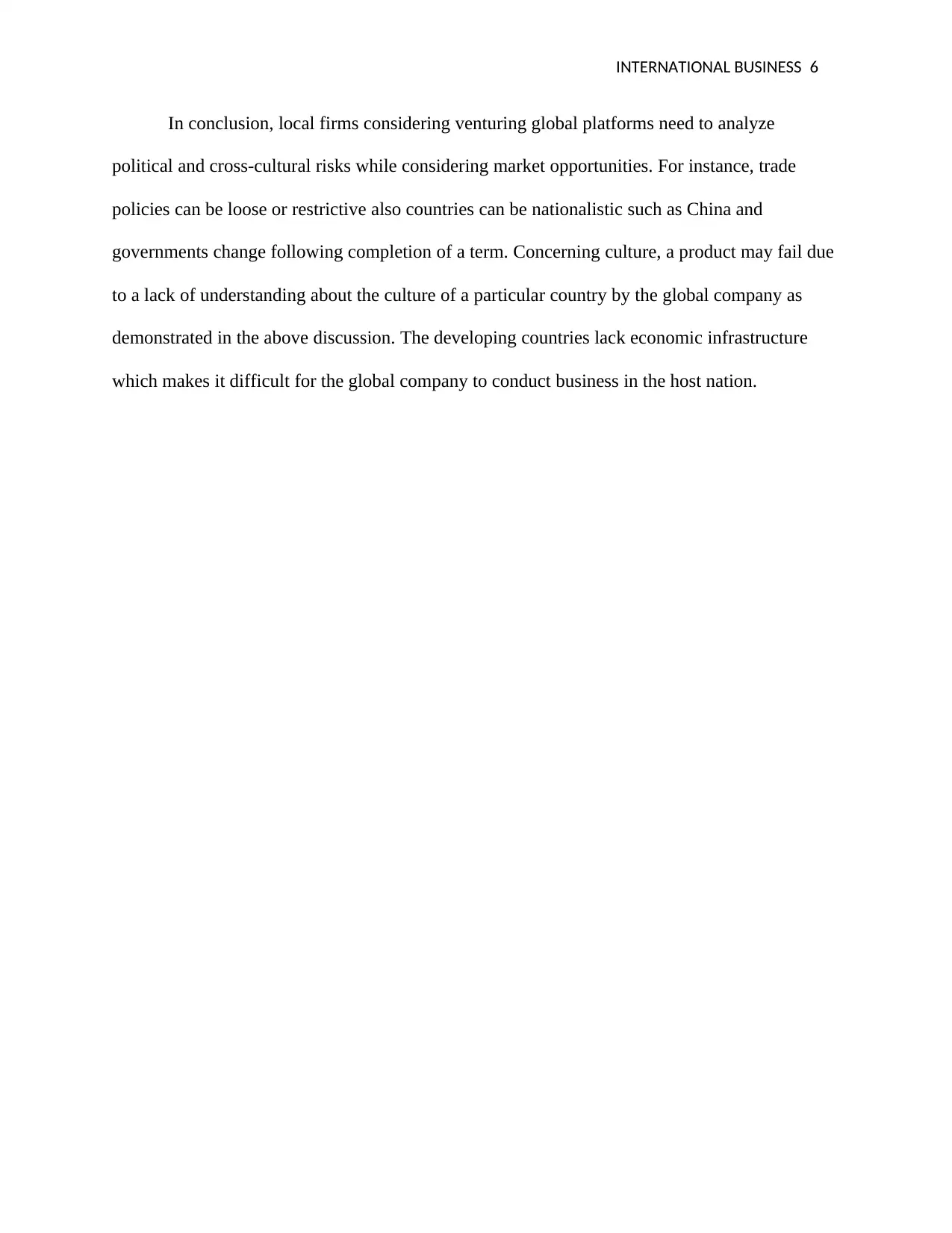
INTERNATIONAL BUSINESS 6
In conclusion, local firms considering venturing global platforms need to analyze
political and cross-cultural risks while considering market opportunities. For instance, trade
policies can be loose or restrictive also countries can be nationalistic such as China and
governments change following completion of a term. Concerning culture, a product may fail due
to a lack of understanding about the culture of a particular country by the global company as
demonstrated in the above discussion. The developing countries lack economic infrastructure
which makes it difficult for the global company to conduct business in the host nation.
In conclusion, local firms considering venturing global platforms need to analyze
political and cross-cultural risks while considering market opportunities. For instance, trade
policies can be loose or restrictive also countries can be nationalistic such as China and
governments change following completion of a term. Concerning culture, a product may fail due
to a lack of understanding about the culture of a particular country by the global company as
demonstrated in the above discussion. The developing countries lack economic infrastructure
which makes it difficult for the global company to conduct business in the host nation.
⊘ This is a preview!⊘
Do you want full access?
Subscribe today to unlock all pages.

Trusted by 1+ million students worldwide
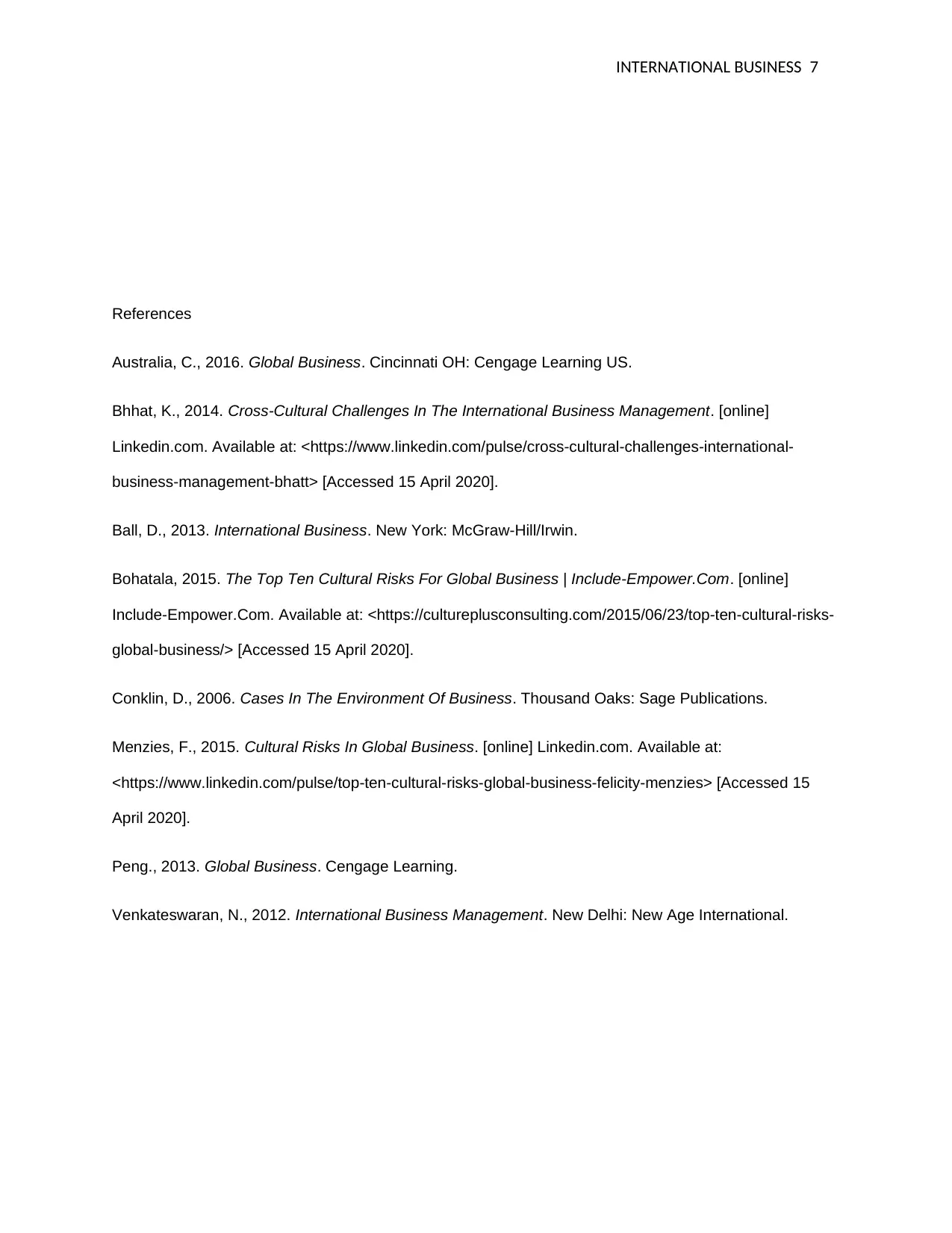
INTERNATIONAL BUSINESS 7
References
Australia, C., 2016. Global Business. Cincinnati OH: Cengage Learning US.
Bhhat, K., 2014. Cross-Cultural Challenges In The International Business Management. [online]
Linkedin.com. Available at: <https://www.linkedin.com/pulse/cross-cultural-challenges-international-
business-management-bhatt> [Accessed 15 April 2020].
Ball, D., 2013. International Business. New York: McGraw-Hill/Irwin.
Bohatala, 2015. The Top Ten Cultural Risks For Global Business | Include-Empower.Com. [online]
Include-Empower.Com. Available at: <https://cultureplusconsulting.com/2015/06/23/top-ten-cultural-risks-
global-business/> [Accessed 15 April 2020].
Conklin, D., 2006. Cases In The Environment Of Business. Thousand Oaks: Sage Publications.
Menzies, F., 2015. Cultural Risks In Global Business. [online] Linkedin.com. Available at:
<https://www.linkedin.com/pulse/top-ten-cultural-risks-global-business-felicity-menzies> [Accessed 15
April 2020].
Peng., 2013. Global Business. Cengage Learning.
Venkateswaran, N., 2012. International Business Management. New Delhi: New Age International.
References
Australia, C., 2016. Global Business. Cincinnati OH: Cengage Learning US.
Bhhat, K., 2014. Cross-Cultural Challenges In The International Business Management. [online]
Linkedin.com. Available at: <https://www.linkedin.com/pulse/cross-cultural-challenges-international-
business-management-bhatt> [Accessed 15 April 2020].
Ball, D., 2013. International Business. New York: McGraw-Hill/Irwin.
Bohatala, 2015. The Top Ten Cultural Risks For Global Business | Include-Empower.Com. [online]
Include-Empower.Com. Available at: <https://cultureplusconsulting.com/2015/06/23/top-ten-cultural-risks-
global-business/> [Accessed 15 April 2020].
Conklin, D., 2006. Cases In The Environment Of Business. Thousand Oaks: Sage Publications.
Menzies, F., 2015. Cultural Risks In Global Business. [online] Linkedin.com. Available at:
<https://www.linkedin.com/pulse/top-ten-cultural-risks-global-business-felicity-menzies> [Accessed 15
April 2020].
Peng., 2013. Global Business. Cengage Learning.
Venkateswaran, N., 2012. International Business Management. New Delhi: New Age International.
1 out of 7
Related Documents
Your All-in-One AI-Powered Toolkit for Academic Success.
+13062052269
info@desklib.com
Available 24*7 on WhatsApp / Email
![[object Object]](/_next/static/media/star-bottom.7253800d.svg)
Unlock your academic potential
Copyright © 2020–2025 A2Z Services. All Rights Reserved. Developed and managed by ZUCOL.





